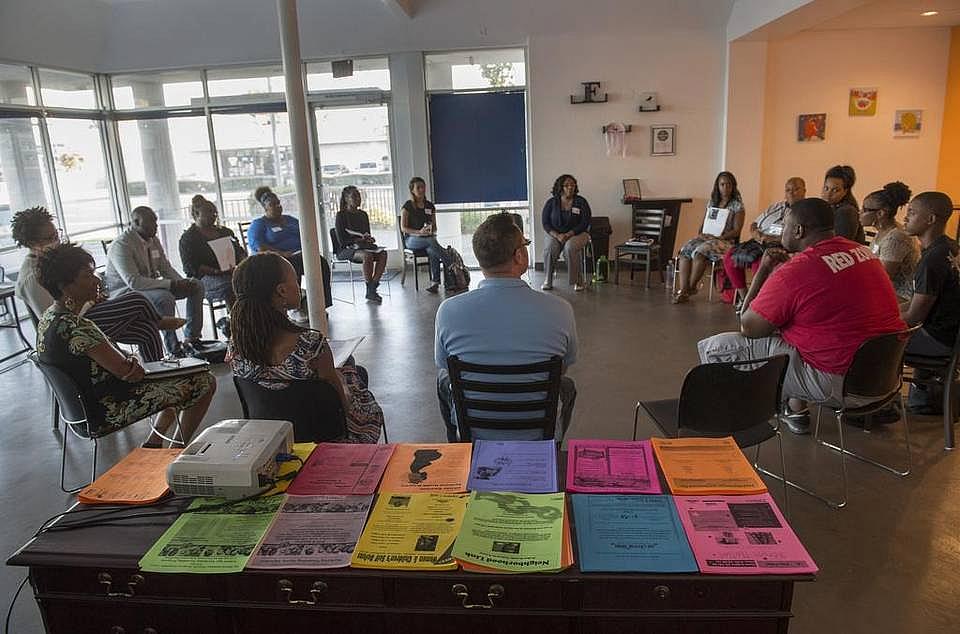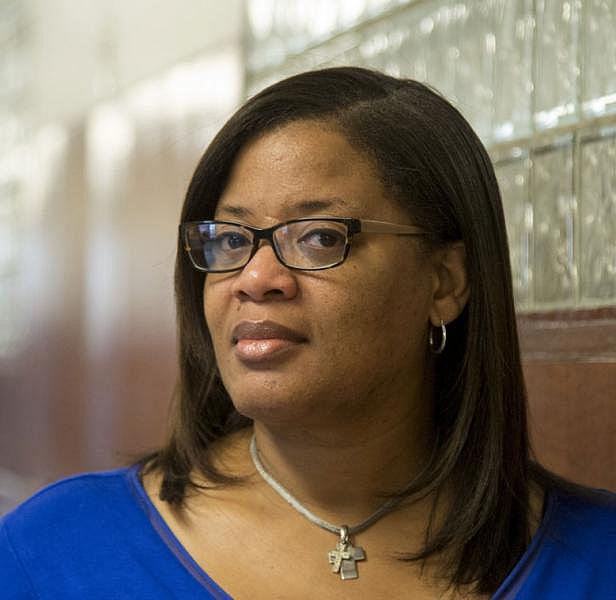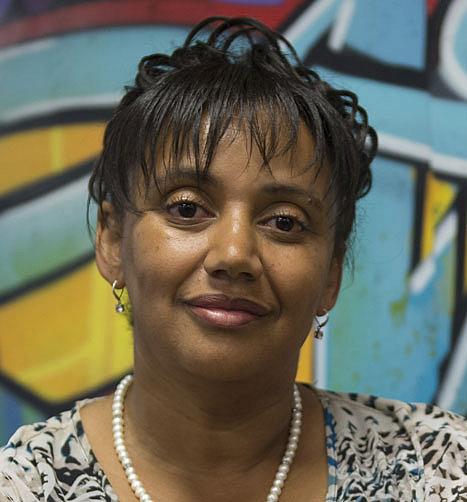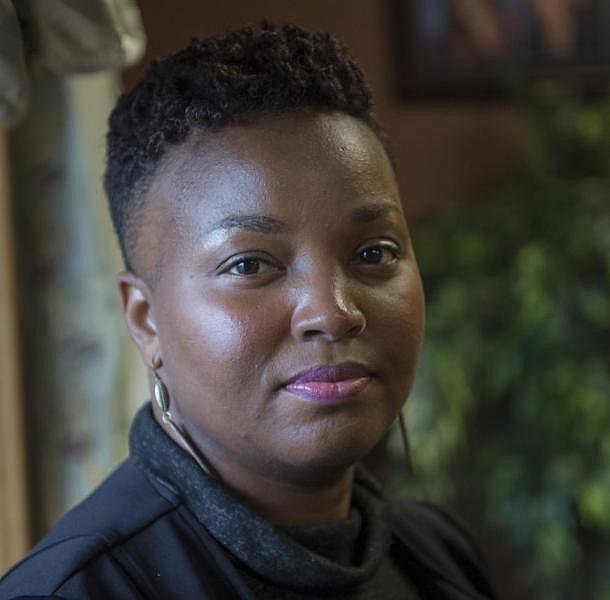The seven leaders who are putting the focus on Sacramento’s black children
This article was produced as a project for the 2015 California Data Fellowship, a program of the USC Center for Health Journalism.
Other stories in the series include:
Black children die at alarming rate in Sacramento County, and here’s why
City of Sacramento joins efforts to prevent black children’s deaths
Black babies die in sleep at higher rates in Sacramento. Why? And can we fix it?

Community leaders meet every month at the Arcade Community Center to talk about ways to bring down the high death rate among the area’s African American children. Lezlie Sterling lsterling@sacbee.com
The chatter of children in a bright yellow activity center is the only sign of life in south Sacramento’s otherwise desolate Phoenix Park apartment complex.
Inside, children line up for an after-school snack before shuffling to supervised recess and homework help with the Focus on Family Foundation, a local nonprofit group. Many of the kids come from homes riddled by domestic conflict, said director Jackie Rose, and if not for the daily program, they wouldn’t have access to healthy foods, tutoring and a safe place to hang out.
Rose, 62, has been working to improve conditions in the neighborhood for the last two decades. Dressed in a yellow blazer reflective of her vibrant personality, she looks on at the hundred or so students with the pride of a grandmother. Soon she hopes to get them more mentors, activities and other resources, with the help of the $360,000 her group will receive from a sweeping Sacramento County effort to protect more African American children at home and in the streets.
It’s the sort of game-changing aid – $2.5 million over the next three years – that Focus on Family and six other Sacramento County nonprofit groups say they need to grapple with the county’s alarmingly high rates of black child deaths. Including money spent on a range of other services, the county has dedicated $26 million to the effort, and matriarchs, health workers and other leaders in seven of the most affected neighborhoods are making big plans for change.
Between 2010 and 2015, African American children in Sacramento County died at far higher rates than those of people under age 18 from other racial or ethnic groups. Nearly a quarter of the 873 children in the county who died during those six years were black, although African Americans made up just 11 percent of the age group. As a result, black children died at more than twice the rate of white youths and about three times the rate for Latino and Asian children, according to a Sacramento Bee review of state death certificates.
The most common causes of death for black children were prenatal conditions, sleep incidents and violence in or out of the home.
Danielle Lawrence of Mutual Assistance Network, an Arden area nonprofit agency that receives county funding, said the causes of those early deaths can usually be traced to poverty and drug and alcohol addiction as well as domestic conflict. Some happen in isolated households and apartment complexes, where parents are so overwhelmed that they don’t enroll in safe sleep classes, after-school programs, food assistance and other available resources, she said.
“Often, they’re so muddled in the muck and mire of their crisis, they may not even think to speak to their child or to take care of what they need to,” Lawrence said. “I haven’t seen it get better. We’re working hard to establish trust.”
The new grants will help groups like Lawrence’s connect to more families needing help, whether it’s through community forums, street festivals, sidewalk outreach or youth programs.
Each organization will also house on-site county employees from Child Protective Services, probation and other departments.
“What we’re seeing now is the redesign of a public infrastructure to get at some longstanding problems, including the perception that these public institutions are not really there to help us,” said Chet Hewitt, president of the Sierra Health Foundation, which helped select the groups and distribute the grants.
In interviews with The Bee, the leaders of seven nonprofit groups explained the problems they see in their neighborhoods, and their visions for solving them.
1. Danielle Lawrence, Arden Arcade

Organization name: Mutual Assistance Network
Who lives there: 63 percent white, 19 percent Hispanic, 9 percent black, 4 percent Asian, 0.4 percent Native Hawaiian/Pacific Islander, 0.4 percent American Indian/Alaskan Native, 4 percent other
Median household income: $38,464 (countywide: $55,615)
Households with no workers: 50 percent (countywide: 32 percent)
What have been the biggest problems in your neighborhood? “Arden Arcade isn’t very neighborhood-oriented. These folks have been previously evicted. The people are very transient. They come, they leave. They’re isolated, and for very good reason. This wasn’t created to be a destination.”
How will you use the funds to make an impact? “We can’t end poverty. We can’t end racism. But there are practical things we can do to solve the problem, like focus on providing safe sleep curriculum and portable cribs, home visitations, working with youth, pregnant teens, homeless teens and teens who will do campaign work for stipends.”
2. Kim Williams, Fruitridge

Organization name: Sacramento Building Health Communities, also known as The Hub
Who lives there: 40 percent Hispanic, 29 percent Asian, 15.5 percent white, 8.5 percent black, 1.6 percent Native Hawaiian/Pacific Islander, 0.3 American Indian/Alaskan Native, 5 percent other
Median household income: $28,447
Homes where householder has not finished high school: 42 percent (countywide: 34 percent)
What have been the biggest problems in your neighborhood? “In general, there’s always been a sense that local government really doesn’t care about them. They’re frustrated. Their voice isn’t heard. The things in their community don’t get taken care of. The amount of dumping you see in these communities – the boarded up homes, the empty lots. When you drive through the communities and see all this and then you go to them, it’s very difficult to get them to come out and be involved because they just feel like they won’t be listened to.”
How will you use the funds to make an impact? “The first thing we’re going to do is a neighborhood scan. Let’s find out who’s in this community doing work that we may just not know of yet. If someone is doing something successful on a small scale, maybe we need to partner with them and bring them in so we can expand their scale. … Our goal is to make sure that our folks are out in the community as much as possible so they can start to build trust. We want to be out there as much as we can be, so they know we’re in for the long haul and not just trying to check off a box.”
3. Ray Green, Del Paso Heights

Organization name: Roberts Family Development Center
Who lives there: 36 percent Hispanic, 25 percent white, 17 percent Asian, 15 percent black, 3 percent Native Hawaiian/ Pacific Islander, 1 percent American Indian/Alaskan Native, 3 percent other
Median household income: $39,481
Households run by single mothers: 13 percent (countywide: 8 percent)
What have been the biggest problems in your neighborhood? “We’re still working on bridging that gap of knowledge and wisdom from the older generation to the younger generation. To be able to educate high schoolers, middle schoolers, faith-based communities – these are things they may not even be aware of.”
How will you use the funds to make an impact? “We’ll be doing birth and beyond projects and home care amongst a plethora of other resources, particularly honing in on safe sleep baby and making it very specific for our target group in Del Paso Heights.”
4. Paris Dye, Foothill Farms

Organization name: Liberty Towers Church
Who lives there: 55 percent white, 23 percent Hispanic, 9 percent black, 5 percent Asian, 1.3 percent American Indian/Alaskan native, 0.3 percent Native Hawaiian/ Pacific Islander, 6.4 percent other
Median household income: $44,542
Homes where householder has no health insurance: 17 percent (countywide: 14 percent)
What have been the biggest problems in your neighborhood? “As (Foothill Farms) started to decline during the housing crash, a lot of people were misplaced. A lot of kids started falling through the cracks. We lost good leadership in the athletic leagues. Things just declined very slowly, and people started pulling their kids out one at a time.”
How will you use the funds to make an impact? “I’d like to see opportunities for people to learn. I want them to learn about the causes of death, but I also want them to learn about their own home and their own people – conflict management, conflict resolution. I would love to see that happen.”
5. Katrina Simmons, Valley Hi

Organization name: South Sacramento Christian Center Church
Who lives there: 33 percent Hispanic, 22 percent black, 22 percent Asian, 15 percent white, 2.3 percent Native Hawaiian/Pacific Islander, 0.1 percent American Indian/Alaskan native, 2.9 percent other
Median household income: $36,731
Homes where householder has not finished high school: 39 percent
What have been the biggest problems in your neighborhood? “(Services) have to be convenient. In this area things are too spread out, too disconnected.”
How will you use the funds to make an impact? “With this opportunity, we can have that one-stop shop where you can come to one place and find what you need, instead of needing to get a ride or catch the bus.”
6. Jackie Rose, Meadowview

Organization name: Focus on Family Foundation
Who lives there: 30 percent Hispanic, 29 percent white, 19 percent Asian, 15 percent black, 2 percent Native Hawaiian/ Pacific Islander, 0.3 American Indian/Alaskan native, 5 percent other
Median household income: $44,392
Homes where householder has no health insurance: 15 percent
What have been the biggest problems in your neighborhood? “Families are very fractured. The structure that used to be in place in the African American families is no longer there, in many cases. It affects the children socially and emotionally because of the absence of the father. It’s very hard for them.”
How will you use the funds to make an impact? “We have a lot of community-rich, community-based organizations but we’re not talking to each other. … We plan to hire a program manager who will be in charge of really looking at gauging and tracking. We also plan to use Antioch Baptist church as a major hub to get people to understand that that is the place you can go to to really get what you need.”
7. Tamika L’Ecluse, Oak Park

Organization name: Greater Sacramento Urban League
Who lives there: 42 Hispanic, 30 percent white, 11 percent black, 11 percent Asian, 0.8 percent Native Hawaiian/ Pacific Islander, 0.5 percent American Indian/Alaskan native and 5 percent other
Median household income: $40,730
Households with no workers: 47 percent
What have been the biggest problems in your neighborhood? “With Oak Park, the gentrification topic comes up a lot, and the preservation of the black culture here in the community. Most of the conversations we have as a neighborhood do center around kids – the programs for kids. How do we keep good mentors? How do we have safe places for them? How do we treat and accept and coach and encourage them? And who’s responsible for that? At the end of the day it’s everybody, every one of us.”
How will you use the funds to make an impact? “The key is the people who are already here – the people who are the barber shop owners, the corner store workers, the locksmith everybody goes to. Those people who have built their connection to the community through their trade and from being in a place where people feel they belong. … People will start to bring it back to the Urban League. Once that becomes a regular conversation, I think people will continue to look to us to be that link.”

